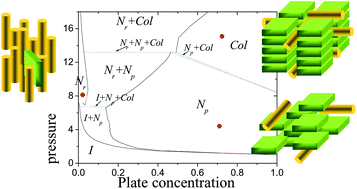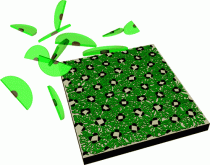S. D. Peroukidis, A. G. Vanakaras and D. J. Photinos, J. Mat. Chem., 20, 10495-10502, (2010).
 Abstract. A theoretical model of shape-anisometric particles embedded in a cubic lattice is formulated for binary mixtures combining rod-like, plate-like and spherical particles. The model aims at providing a tool for the prediction and interpretation of complex phase behavior in a variety of liquid crystalline colloids, biological and macromolecular systems. Introducing just repulsive interactions among the particles, a rich variety of phase structures and multiphasic equilibria is obtained, including isotropic, nematic, lamellar and columnar phases, demixing into phases of the same or different symmetries and structural microsegregation of the different species of the mixture within the same phase.
Abstract. A theoretical model of shape-anisometric particles embedded in a cubic lattice is formulated for binary mixtures combining rod-like, plate-like and spherical particles. The model aims at providing a tool for the prediction and interpretation of complex phase behavior in a variety of liquid crystalline colloids, biological and macromolecular systems. Introducing just repulsive interactions among the particles, a rich variety of phase structures and multiphasic equilibria is obtained, including isotropic, nematic, lamellar and columnar phases, demixing into phases of the same or different symmetries and structural microsegregation of the different species of the mixture within the same phase.
This article is part of the collection: Modelling of Materials (c) http://pubs.rsc.org | doi:10.1039/C0JM01692F
S. Droulias, A.G. Vanakaras, D.J. Photinos, Liquid Crystals, 37:6, 969-976, (2010).
Abstract: A theory of thermotropic nematic liquid crystals in which molecules form internally ordered clusters is presented. The formulation is based on the same m ean field approximation and form of the anisotropic potential used in the Maier-Saupe theory. A uniaxial nematic and two macroscopically isotropic phases are predicted. One of the isotropic phases consists of thermodynamically stable clusters with internal orientational order. The nematic phase shows cybotactic order throughout its range of stability. This order persists above the transition temperature, either as a stable feature or as a pretransitional effect. The values of the order parameter and of the entropy change at the nematic to isotropic phase transition depend on the size of the clusters. The Maier-Saupe theory is obtained in the limit of extremely large or extremely small clusters. URL: http://dx.doi.org/10.1080/02678292.2010.488819
ean field approximation and form of the anisotropic potential used in the Maier-Saupe theory. A uniaxial nematic and two macroscopically isotropic phases are predicted. One of the isotropic phases consists of thermodynamically stable clusters with internal orientational order. The nematic phase shows cybotactic order throughout its range of stability. This order persists above the transition temperature, either as a stable feature or as a pretransitional effect. The values of the order parameter and of the entropy change at the nematic to isotropic phase transition depend on the size of the clusters. The Maier-Saupe theory is obtained in the limit of extremely large or extremely small clusters. URL: http://dx.doi.org/10.1080/02678292.2010.488819
G.A. Tritsaris and A.G. Vanakaras,
; DOI: 10.1021/la904613j.
 Abstract: We demonstrate by computer experiments that the spontaneous formation of two-dimensional regularly patterned molecular networks containing voids may be an entirely entropy-driven process. On the basis of a simple model of core−(soft) shell half-disk-shaped particles, we show that, even without the mediation of any attractive interparticle forces, such particles self-organize to stable and macroscopically ordered patterns with regularly distributed voids. The morphology of these supramolecular porous motifs depends critically on the size of the core relative to the coronal halo. The reverse engineering analysis of these precise two-dimensional supramolecular porous templates suggests molecular-shape complementarity and polyphilicity as key design parameters for the bottom-up engineering of such functional substrates.
Abstract: We demonstrate by computer experiments that the spontaneous formation of two-dimensional regularly patterned molecular networks containing voids may be an entirely entropy-driven process. On the basis of a simple model of core−(soft) shell half-disk-shaped particles, we show that, even without the mediation of any attractive interparticle forces, such particles self-organize to stable and macroscopically ordered patterns with regularly distributed voids. The morphology of these supramolecular porous motifs depends critically on the size of the core relative to the coronal halo. The reverse engineering analysis of these precise two-dimensional supramolecular porous templates suggests molecular-shape complementarity and polyphilicity as key design parameters for the bottom-up engineering of such functional substrates.
, and .


